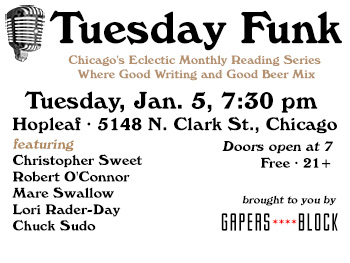| « Visiting Lecture at the Read/Write Library | Arctic Adventure Multimedia Presentation in Evanston » |
Books Tue May 29 2012
A Review of The Brightest Thing in the World: 3 Lectures from The Institute of Failure
"We may agree on the premise that each work of art is at least in part perfect, while each critic is at least in part imperfect. We may then look to each work of art not for its faults and shortcomings, but for its moments of exhilaration, in an effort to bring our own imperfections into sympathetic vibration with these moments, and thus effect a creative change in ourselves. These moments will of course be somewhat subjective, and if we don't see one immediately, we will out of respect look again, because each work contains at least one, even if by accident. We may look at the totality of the work in the light of this moment - whether it be a moment of humor or sadness, an overarching structural element, a mood, a personal association, a distraction, an honest error, anything that speaks to us."
-Matthew Goulish, 39 Microlectures.
SAIC Professor Matthew Goulish's new book The Brightest Thing in the World: 3 Lectures from The Institute of Failure contains what seems like millions of those moments of exhilaration--too many to report here. Like much of Goulish's work the book is a series of lectures that weave together seemingly disconnected scraps of real life; Dick Cheney's fateful quail debacle, the development of the Fibonacci series, pets abandoned in the aftermath of Hurricane Katrina, and death as we relate to it either viscerally or with detached fascination. He investigates what one's death can say about one's life, or not.
The collection, published by Green Lantern Press earlier this month, was drawn from Goulish's existing work, each piece selected for its resonance on the page. These works, Goulish explains in the book's introduction, stand the test of time, context, and medium, extending beyond the room in which they were first delivered, and on to the page. He asks, "Can a book make the room larger?" which for me, means that the book is part of the performance, an experiment of sorts, investigating whether text built for a particular moment in history, engineered for speaking aloud, can make the private act of reading an extension of that performance.
Appropriately, in the first lecture, "Audience Failure Index," Goulish describes the ways an audience can fail to properly consume a performance--be it a movie, or a piece of theater--according to social expectation. It is described in the early pages as, "...watching the show as the show intends itself to be watched. As such the lecture was to provide a reverse-engineered instruction manual for the intentional enactment of audience failure; a how-to guide for the unsatisfied." (15) Here, Goulish refers to a project he embarked on with friend and colleague, Tim Etchells, called The Institute of Failure, which operated on precisely this basis. As a reading audience we too are implicated here as consumers of the work in its new medium. From here, the lecture moves to new terrain, in a way that seems both highly calculated and like a stream of consciousness. Goulish's language is poetic and conversational at the same time, occasionally edging towards something clinical and journalistic. It seems to tell us he is actively processing his thoughts and that we are witnessing something as it unfolds anew, like a series of summersaults, much as one might feel at a live lecture.
Goulish performs one of those summersaults early on in "Audience Failure Index," moving from a direct examination of the audience via his own ideas and passages of other's work (Proust, Camus) to Dick Cheney's quail hunting incident. He says, "The apotropaic audience, that looks away at the threshold, turns its attention elsewhere, foregrounding a negative space and backgrounding the performance, and in the act harnesses the force of time. Thus was the extent of my thought on the subject at the moment when Vice President Dick Cheney shot a man in the face." (19) He describes the narrative with which the general public was presented, followed by a diagram of the scene and what he perceives as a truer account of the afternoon's events. Many more well architectured shifts follow and move the lectures forward.
The Final Lecture, "The Brightest Thing in the World: A Portrait of Visionary Naturalist W.N.P. Barbellion & Tribute to Historian and Teacher George Roeder," we're told, was intended to examine the last days in the life of Barbellion. The scientist's exhaustive daily journal keeping transports easily and lends to interesting conjecture. At the time that Goulish began this piece of writing though, he suffered the great loss of a close friend and colleague, which derailed him from his academic pursuit. Here, in alternating snippets between history and real loss, Goulish bares himself, letting us in on the nature of this interruption in writing and in life. The most emotionally jarring of the three lectures, this one succeeds on an entirely different avenue.
Jane Blocker writes in the book's introduction of Goulish's performance project Goat Island, "As Charles Garoian (writing about a Goat Island workshop....) has noted about these pedagogical practices, the curriculum is constituted by interruptions, based on interventions designed to break continuity and disrupt the conventional linearity of time and space." Goulish's reader audience may approach this work with a series of expectations based on what is understood as a lecture, what results the solitary act of reading usually delivers, and likely much more. Goulish's work is to disrupt those pressures, acknowledging and ultimately deconstructing the potential impact those burdens have on art. Readers may feel unsteady at first, but it is not difficult to delve completely into Goulish's world and to feel certain guidelines of readership recede, giving way to his utterly unique voice.










peter pero / June 8, 2012 11:17 AM
how can i join book club? got any info on tours of chicago?